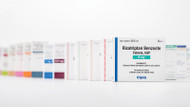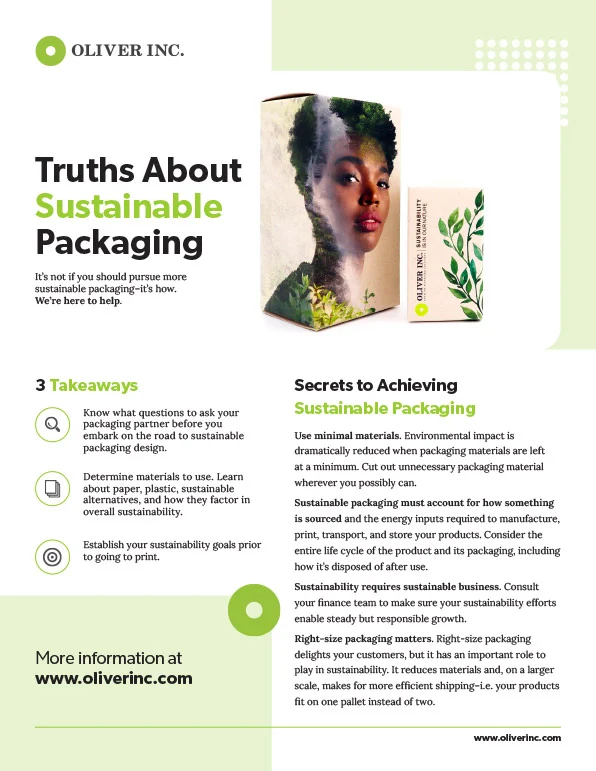Sustainable Pharmaceuticals: The Role Packaging Plays
Posted by Oliver Inc. on 31st Mar 2022
Many packaging solutions for pharmaceuticals are available, but one aspect you don’t want to overlook is sustainability. Sustainable packaging is already becoming mainstream in food and beverage, health and beauty, and even CBD and cannabis.
Here are several ways sustainable pharmaceutical packaging can help your products stand out, attract more consumers, and foster more brand affinity.
Sustainable Packaging for Pharmaceuticals
In simple terms, sustainable packaging is about reducing your ecological impact and carbon footprint. Choosing packaging materials and how they’re manufactured, printed, shipped, and disposed after use are all part of the equation. That also includes the energy source inputs and waste outputs throughout every step of the process.
Materials
Traditional paperboard can be quite sustainable, if sourced from responsibly managed forests, but there are alternative materials worth considering, as well.
Tree-free alternatives made from hemp, sugarcane bagasse, straw, recycled cotton fibers, or other biodegradable materials are available. Another valuable resource for brands which depend on folding cartons is 100% post-consumer recycled paperboard.
While sustainable packaging efforts tend to focus on materials, don’t overlook soy- and vegetable-based inks. They are just as visually effective as petroleum-based inks and less expensive, leaving brands little reason to keep using decorative effects derived from fossil fuels.
Right-Size Packaging
Using only what you need is a fundamental tenet of sustainability. Right-size packaging involves brands using only as much material necessary to preserve, protect, and secure a product while it is shipped, stored, and waiting to be used.
This is cost-effective and green for two reasons: You’re using fewer materials, which means less waste is produced and less raw materials are required, and shipping costs are diminished.
When a product is packaged with excessive material, it ends up weighing more and taking up more space, including gratuitous air pockets in packaging, which drives up shipping costs. These empty cavities are commonly referred to as the “air tax.”
Limiting Carbon Footprint
Carbon emissions are the primary culprit for climate change. Fortunately, there are a few straightforward things brands can do to limit their carbon footprint. Of course, shifting to more renewable energy sources is one, but they can also collaborate with third parties committed to green initiatives, as well. This helps ensure materials or manufacturing processes are ecologically friendly and have minimal impact on the environment.
Additionally, shortening one’s supply chains reduces the amount of distance shipments travel, whether it’s finished products or raw materials. For instance, a pharmaceutical brand may ponder whether their sustainability initiatives should also include working with a domestic printing and packaging partner rather than an international or non-regional provider.
Given the many factors that go into sustainable pharmaceutical packaging, brands have many opportunities for becoming more environmentally responsible.
For example, when looking to make a blister card more sustainable, a brand can account for whether the timber used is sourced sustainably or materials are recyclable, shorten the distance shipped goods travel, or reduce the amount of materials used to store and ship products. They may also identify whether chemicals or inks employed during the process are renewable, and whether any animal habitats are negatively impacted throughout the entire chain of custody.
Roles Sustainable Packaging Plays for Pharmaceuticals
While choosing sustainable packaging leaves a positive environmental impact and encourages others to also go green, there are a few other ways it can add value for pharmaceutical companies.
These are just a few of them.
Builds Brand Affinity
With a growing number of eco-conscious consumers, sustainable packaging provides pharmaceutical brands the opportunity to foster a strong sense of brand loyalty. In fact, a 2020 article in Environment + Energy Leader suggests that 75% of consumers are willing to pay premium prices for sustainable packaging.
By showcasing your commitment to sustainability, be it in the materials you use, your alignment with right-size packaging, or clear labels on packaging identifying your product as sustainably sourced, you’re making it easier for environmentalist consumers to purchase your pharmaceutical products.
Communicates Your Values
Many consumers believe their purchasing decisions should reflect their deepest moral or ethical values, as well as represent other key aspects of their personality. They become loyal to a brand because it reflects who they are. By communicating as a brand that you value sustainability, you enable consumers to feel like they’re doing the same with every purchase they make.
Attracts Consumer Attention
In competitive markets, pharmaceutical brands are looking for any edge they can get, and sustainable packaging offers one. When so many products appear so similar or generic, sustainable packaging provides another avenue for brands to stand out.
Consumers may not know all that much about your company, or even the product, but when they can pick it up off the shelf and clearly read that your packaging has been certified by environmental organizations such as the nonprofit Forest Stewardship Council (FSC), Sustainable Forest Initiative (SFI), or Programme for the Endorsement of Forest Certification (PEFC), they take notice.
Embracing sustainability in pharmaceutical packaging is a great way to make a positive social change, but it also helps elevate your brand.
In order to shift toward a more sustainable packaging strategy, you’ll want to consult an experienced printing partner who knows the ins and outs of green packaging. They’ll help you identify which materials are most appropriate for your needs, and which methods you can introduce into your current packaging processes.






